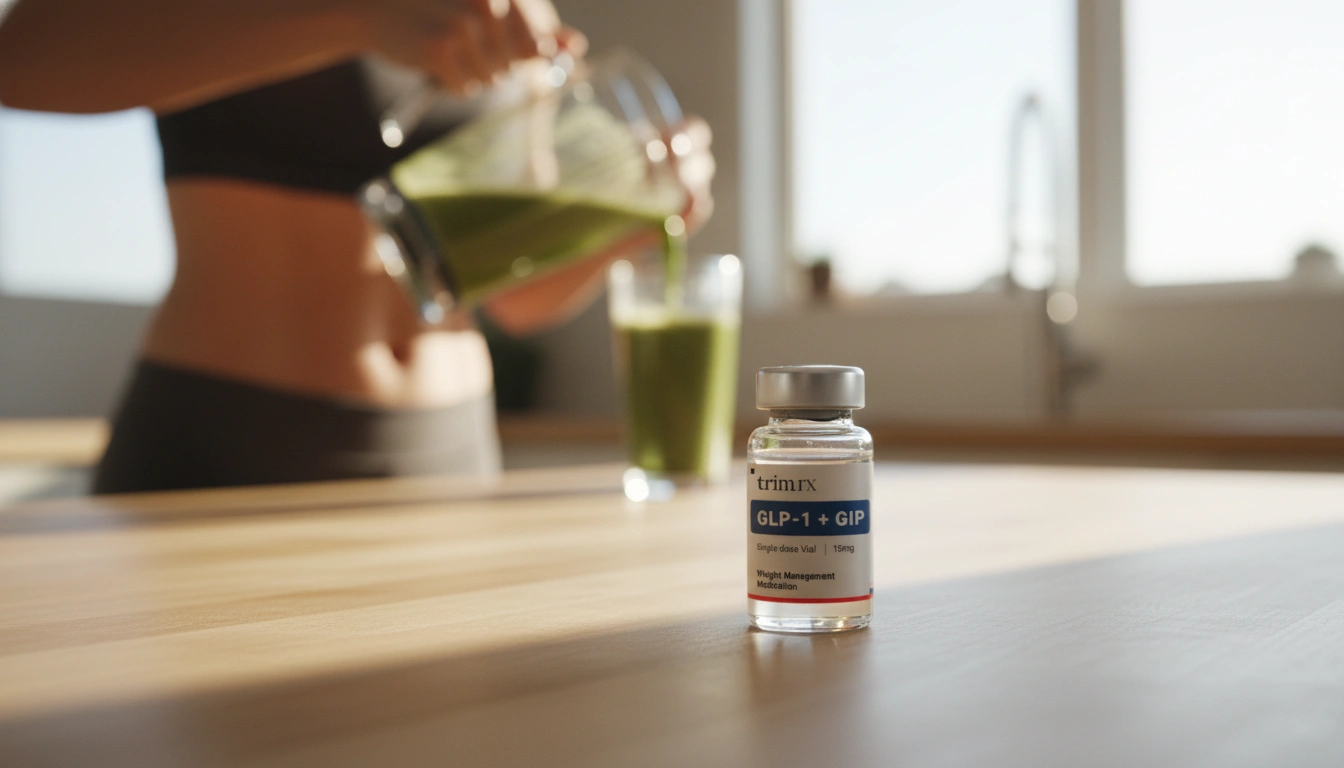How GLP-1 is Produced: A Deep Dive into Its Mechanisms and Impact

Introduction
Did you know that the human body relies on a complex network of hormones to regulate blood sugar levels? One of the most fascinating among them is glucagon-like peptide-1 (GLP-1). This hormone, integral to the management of glucose metabolism, is produced in response to food intake, yet many people are unaware of how it is generated and its importance in our daily lives.
GLP-1 plays a critical role in stimulating insulin secretion, suppressing glucagon release, and even managing appetite. Given the current obesity epidemic and the increasing prevalence of type 2 diabetes, understanding how GLP-1 is produced and functions can offer valuable insights into potential treatments and lifestyle adjustments.
In this blog post, we will explore the intricate process of GLP-1 production, its physiological roles, and the implications this has for health and disease management. We will also touch on how the gut microbiota and dietary choices can influence GLP-1 levels, and how TrimRx’s personalized weight loss programs tap into these biological processes to support sustainable weight management.
By the end, you will have a comprehensive understanding of GLP-1, its production, and its significance in our metabolic health. We invite you to engage with this topic, reflect on your own health journey, and consider how a better understanding of GLP-1 might influence your approach to diet and weight management.
The Basics of GLP-1
What is GLP-1?
GLP-1 is a 30-amino-acid peptide hormone that belongs to the incretin family. It is primarily produced in the L-cells of the intestine, specifically in the distal ileum and colon, but it can also be synthesized in certain neurons in the brain. This hormone is released in response to nutrient intake, particularly carbohydrates, and plays a vital role in glucose homeostasis.
The Role of GLP-1 in Metabolism
Once released into the bloodstream, GLP-1 performs several key functions:
- Stimulating Insulin Secretion: GLP-1 enhances the secretion of insulin from pancreatic beta cells in a glucose-dependent manner, meaning it only promotes insulin release when blood sugar levels are elevated.
- Inhibiting Glucagon Release: It suppresses glucagon, a hormone that raises blood sugar levels, thus helping to maintain balance in glucose metabolism.
- Slowing Gastric Emptying: By delaying gastric emptying, GLP-1 promotes a feeling of fullness and reduces appetite, which can help with weight management.
- Promoting Satiety: GLP-1 acts on the brain to signal satiety, reducing the desire to eat and thus contributing to weight loss.
These multifaceted roles make GLP-1 an essential player in maintaining metabolic health, and understanding its production is crucial for developing effective treatments for obesity and diabetes.
Production of GLP-1: The Biological Process
The Proglucagon Precursor
The journey of GLP-1 begins with the proglucagon gene, which is expressed in various tissues, including the pancreas and the gut. The proglucagon peptide is a 180-amino-acid precursor that undergoes tissue-specific post-translational processing to yield various biologically active peptides, including GLP-1.
- Expression of Proglucagon: The proglucagon gene is regulated by different factors depending on the tissue. In the intestine, its expression is stimulated by nutrient intake, while fasting reduces its expression.
- Processing of Proglucagon: In the intestinal L-cells, proglucagon is cleaved by prohormone convertase 1/3 (PC1/3) into several peptides, including GLP-1(1-37), GLP-1(7-37), and GLP-1(7-36) amide. These forms are active and involved in various physiological processes.
The Release Mechanism of GLP-1
Upon food intake, GLP-1 is secreted in a biphasic manner:
- Early Phase: GLP-1 levels rise within 10-15 minutes after eating, likely due to neural signaling and the presence of nutrients in the proximal intestine.
- Late Phase: A second phase of secretion occurs 30-60 minutes after food intake, primarily driven by direct stimulation of L-cells by digested nutrients.
Factors Influencing GLP-1 Secretion
Several dietary components and physiological factors can influence GLP-1 secretion:
- Nutrients: Carbohydrates, fats, and proteins can stimulate GLP-1 release. For instance, fatty acids have been shown to mobilize intracellular calcium stores, leading to increased GLP-1 secretion.
- Gut Microbiota: The diversity and composition of gut microbiota play a significant role in GLP-1 production. Certain probiotics, such as Akkermansia muciniphila, can enhance GLP-1 secretion, highlighting the importance of gut health.
- Hormonal Signals: Other hormones, such as gastric inhibitory polypeptide (GIP) and somatostatin, can modulate GLP-1 secretion, either promoting or inhibiting its release.
The Regulation of GLP-1: Stability and Degradation
The Role of Dipeptidyl Peptidase-4 (DPP-4)
One of the most critical aspects of GLP-1 regulation is its degradation. The enzyme DPP-4 rapidly inactivates GLP-1, limiting its half-life to approximately 2 minutes in circulation. This rapid degradation means that only about 10-15% of released GLP-1 remains intact to exert its effects on blood glucose levels.
Implications of GLP-1 Degradation
The swift inactivation of GLP-1 has significant implications for diabetes management. Understanding this process has led to the development of GLP-1 receptor agonists, which are designed to mimic GLP-1’s effects while being resistant to DPP-4 degradation. This innovation has paved the way for effective treatments for type 2 diabetes and obesity.
The Gut-Brain Connection: GLP-1 and Appetite Regulation
How GLP-1 Influences Eating Behavior
GLP-1 not only regulates glucose levels but also plays a crucial role in appetite control. By acting on receptors in the brain, GLP-1 can signal satiety, helping individuals feel full after meals. This effect is particularly beneficial for those trying to manage their weight.
The Impact of Diet on GLP-1 Levels
Given GLP-1’s role in appetite regulation, dietary choices can significantly affect its production. Foods rich in fiber, healthy fats, and proteins can enhance GLP-1 secretion, while processed sugars may not provide the same benefits.
Incorporating GLP-1-supportive foods into our diets can be a powerful strategy for those looking to improve their metabolic health. Some examples of beneficial foods include:
- Leafy greens and vegetables
- Whole grains such as oats and barley
- Healthy fats from avocados and olive oil
- Nuts and seeds
GLP-1 and Weight Loss: The TrimRx Approach
At TrimRx, we are dedicated to helping individuals achieve sustainable weight loss through personalized and medically supervised programs. Understanding the role of GLP-1 in appetite regulation and glucose metabolism informs our approach to weight management.
Our Personalized Weight Loss Programs
We provide a range of clinically proven, personalized weight loss solutions, including medications like Semaglutide and Tirzepatide, which mimic the effects of GLP-1. These treatments are designed to enhance insulin secretion, suppress appetite, and promote satiety, helping our patients achieve their weight loss goals effectively.
To determine eligibility for these medications and receive a tailored treatment plan, we encourage you to take our free assessment quiz. Start your journey towards healthier living today by visiting TrimRx Assessment Quiz.
Quick-Access Supplements for Immediate Support
In addition to our personalized programs, we offer quick-access supplements to support overall wellness during your weight loss journey. Our GLP-1 Daily Support and Weight Loss Boost supplements are designed to enhance your efforts, providing additional support as you work towards your goals. You can find these supplements here: GLP-1 Daily Support and Weight Loss Boost.
Conclusion
Understanding how GLP-1 is produced and its multifaceted role in metabolism can empower individuals to make informed decisions about their health. From its production in the gut to its rapid degradation and influence on appetite, GLP-1 is more than just a hormone—it is a crucial player in the complex system that governs our metabolic health.
At TrimRx, we believe in the power of personalized care. Our commitment to integrating scientific knowledge with empathetic support allows us to provide effective weight loss solutions tailored to each individual’s unique journey.
As you reflect on the information shared in this post, consider how understanding GLP-1 can impact your own health choices. We invite you to explore our personalized programs and quick-access supplements, designed to support you every step of the way.
FAQ
What is GLP-1 and why is it important?
GLP-1, or glucagon-like peptide-1, is a hormone produced in the intestine that plays a vital role in regulating blood sugar levels, stimulating insulin secretion, suppressing glucagon, and promoting satiety. Its importance lies in its critical functions in maintaining glucose homeostasis and managing appetite.
How is GLP-1 produced in the body?
GLP-1 is produced from the proglucagon peptide, which undergoes post-translational processing in the L-cells of the intestine. Various factors, including nutrient intake, gut microbiota, and hormonal signals, influence its secretion.
What factors can affect GLP-1 levels?
Several factors can influence GLP-1 levels, including dietary choices, the composition of gut microbiota, and hormonal signals from the body. Foods rich in fiber, healthy fats, and proteins can enhance GLP-1 secretion.
How does GLP-1 relate to weight management?
GLP-1 plays a significant role in appetite regulation by signaling satiety and helping to control food intake. Medications that mimic GLP-1 can aid in weight management by promoting these effects.
How can I start my weight loss journey with TrimRx?
To begin your personalized weight loss journey with TrimRx, we encourage you to take our free assessment quiz. This will help determine your eligibility for our prescription weight loss medications and provide you with a tailored treatment plan.
By understanding the production and function of GLP-1, we can better equip ourselves to manage our health and make informed dietary choices that support our overall well-being.

Transforming Lives, One Step at a Time
Keep reading
7 Tips for Sticking to GLP-1 Injection Schedules
Seven practical strategies to keep weekly GLP‑1 injections on schedule—pick a routine day, set reminders, manage side effects, rotate sites, and avoid missed doses.
Custom GLP-1 Dosing for Kidney Disease
Personalized GLP-1 dosing for CKD patients with monitoring, dehydration and hypoglycemia risk mitigation, and guidance across all kidney disease stages.
Semaglutide vs Tirzepatide: Approved Uses
Two leading diabetes and weight-loss drugs differ in FDA-approved benefits — one adds heart, kidney and liver protection; the other treats obstructive sleep apnea.



